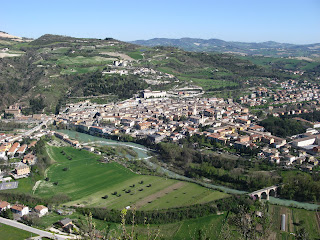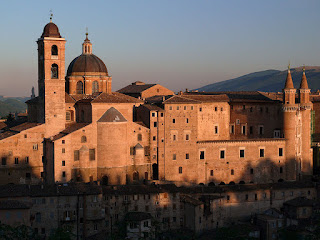NEW - Ottaviano dei Petrucci – music printer
Pioneer in printing who worked for a Doge and a Pope
Ottaviano dei Petrucci, who was the first person to print a book of polyphonic music from movable type, was born on this day in 1466 in Fossombrone near Ancona. It is thought that Petrucci was educated at Urbino, possibly at the humanist court of Guidobaldo da Montefeltro, who was Duke of Urbino apart from a brief period from 1482 until his death in 1508. To learn the art of printing, in 1490 Petrucci went to Venice, then the most advanced centre for printing in Italy. In 1498, Petrucci petitioned the Doge, Agostino Barbarigo, for the exclusive right to print music for the next 20 years, which was granted. There are no examples of printed music produced by other Venetian printers until 1520. Over the years, he continued to refine his technique and he held music printing monopolies in Venice until 1511. He produced books of printed music at the rate of a new book every few months. His collection of 96 chansons, secular songs under the title of Harmonice Musices Odhecaton - One Hundred Songs of Harmonic Music - published in Venice in 1501, was the first book of polyphonic music to be printed from movable type. Read more…
______________________________________
Isabella Rossellini - actress and model
Daughter of ‘cinema royalty’ who became star in her own right
The actress and model Isabella Rossellini, famed for her roles in the David Lynch-directed mystery Blue Velvet and the Oscar-winning black comedy Death Becomes Her and for 14 years the face of luxury perfume brand Lancôme, was born on this day in 1952 in Rome. Her parents were the Swedish triple Academy Award-winning actress Ingrid Bergman and the Italian director Roberto Rossellini, one of the pioneers of the neorealism movement that spawned some of Italy’s finest films. She is the eldest by 34 minutes of twin girls. Resident in the United States since 1979, when she married the American director Martin Scorsese, she has a home on Long Island, New York, where she keeps a number of animals. An active campaigner for various wildlife conservation causes, Rossellini has a MA in Animal Behaviour & Conservation after studying the subject at Hunter College, New York. Although her acting career continues, she moved in a less conventional direction by writing, directing and appearing in a series of short documentary films about sexual and reproductive behaviour in animals entitled Green Porno. Read more…
_____________________________________
Bartolomeo Ammannati – sculptor and architect
Florentine artist created masterpieces for his home city
Bartolomeo Ammannati, whose buildings in Italy marked the transition from the Renaissance to the Baroque style, was born on this day in 1511 at Settignano near Florence. Ammannati began his career as a sculptor, carving statues in a number of Italian cities during the 1530s. He trained first under Baccio Bandinelli and then under Jacopo Sansovino in Venice, working with him on the Library of St Mark, the Biblioteca Marciana, in the Piazzetta. Pope Julius III called Ammannati to Rome in 1550 on the advice of architect and art historian Giorgio Vasari. Ammannati then worked with Vasari and Giacomo da Vignola on the Villa Giulia, which belonged to the Pope. In the same year, Ammannati married the poet Laura Battiferri and they spent the early years of their marriage in Rome. Cosimo I de' Medici brought Ammannati back to Florence in 1555, and it was where he was to spend the rest of his career. His first job was to finish the Laurentian Library begun by Michelangelo. He interpreted a clay model sent to him by Michelangelo to produce the impressive staircase leading from the vestibule into the library. Read more…
______________________________________
Fabio Capello - football manager
Veteran Champions League winner with five Serie A titles
Fabio Capello, one of European club football's most successful managers, was born in San Canzian d'Isonzo, close to the border of Italy and Slovenia, on this day in 1946. Capello is the winner of five Serie A titles as a coach and four as a player, plus two La Liga titles as manager of Real Madrid, and the Champions League with AC Milan. At the time he was born, San Canzian d'Isonzo was in an area occupied by Allied forces after the end of the Second World War. Capello’s uncle, Mario Tortul, who was from the same village near Trieste, had been a professional footballer, playing in Serie A with Sampdoria, Triestina and Padova and making one appearance for the Italian national team. Capello began his playing career at the Ferrara-based SPAL club and went on to represent Roma, Juventus and AC Milan. A midfielder with an eye for goal, he was a Serie A champion three times with Juventus and once with Milan, also winning the Coppa Italia with Roma and Milan. He represented Italy 32 times, playing at the 1974 World Cup finals in West Germany. He regards scoring the only goal against England in 1973 as Italy won at Wembley for the first time in their history as the highlight of his international career. Read more…
_____________________________________
Raffaella Carrà - entertainer and TV presenter
Much-loved star with long and varied career
Raffaella Carrà, the singer, dancer, television presenter and actress often simply known as la Carrà or Raffaella, was born in Bologna on this day in 1943. Carrà has become a familiar face on Italian TV screens as the host of many variety shows and, more recently, as a judge on the talent show The Voice of Italy. She has also enjoyed a recording career spanning 45 years and was a film actress for the best part of 25 years, having made her debut at the age of nine. Her best-known screen role outside Italy was alongside Frank Sinatra in the hit American wartime drama, Von Ryan’s Express. Carrà was born Raffaella Maria Roberta Pelloni. Shew grew up in the Adriatic resort of Bellaria-Igea Marina, just north of Rimini, where her father ran a bar and her maternal grandfather an ice cream parlour. At the age of eight, she won a place at the National Dance Academy in Rome and from there moved to the Centro Sperimentale di Cinematografia, Italy’s oldest film school. Her film career was never more than modestly successful. Although she has a long list of credits, she was cast mainly in small parts. Read more…

.jpg)

.jpg)





.jpg)

.jpg)

.jpg)
.jpg)
.jpg)
